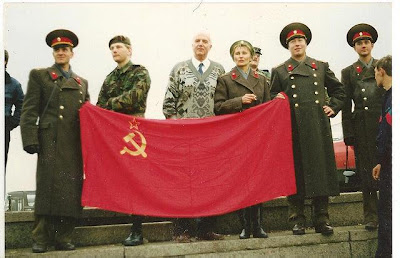The Group of Soviet Forces in Germany as it was known from 1949 to 1988 or Группа советских войск в Германии, ГСВГ in Cyrillic, also known as the Group of Soviet Occupation Forces in Germany initially from 1945 through 1949 with the formation of West & East Germany and it was finally known as the Western Group of Forces from the period of 1988 through to the dissolution of the Soviet Union in 1994. This was the group of troops that comprised the Soviet Army in East Germany.
The Soviet armies permanently stationed in Germany were the primary land based military threat to NATO and Western Europe from the end of the Second World War in 1945 until the collapse of the German Democratic Republic in 1989, and poised a primary factor in the military situation during the Cold War. The possibility of a Soviet invasion of West Germany and other Western European countries was however kept low due to the dangers of nuclear escalation as declared in the NATO rapid response doctrine.
The Group of Soviet Occupation Forces, Germany, was formed after the capitulation of German forces and the end of the Second World War from formations of the 1st and 2nd Belorussian Fronts.
Withdrawals from East Germany in 1956,1957 and 1958 respectively comprised more than 70,000 Soviet army personnel, including the staff of the Soviet 18th Army.
GSFG had the task to ensure for the adherence to the regulations of the Potsdam Agreement. Furthermore, they represented the political and military interests of the Soviet Union. In 1957 an agreement between the governments of the Soviet Union and East Germany laid out the arrangements over the temporary stay of Soviet armed forces on the territory of the German Democratic Republic, the numerical strength of the Soviet troops, and their assigned posts and exercise areas. It was specified that the Soviet armed forces were not to interfere into the internal affairs of the GDR, as they had done in the earlier years during the Uprising of 1953 in East Germany.
Following a resolution of the government of the USSR in 1979 and 1980 20,000 army personnel, 1,000 tanks and much of their equipment was withdrawn from the territory of East Germany, among these units included the 6th Guards Tank Division.
In the course of Mikhail Gorbachev's Perestroika reforms the GSFG was realigned as a more defensive oriented force in regards to strength, structure and equipment. This entailed a clear reduction of the armored forces in 1989. The GSFG was renamed the Western Group of Forces on June 1, 1989. The withdrawal of the GSFG was one of the largest peacetime troop transfers in military history. Despite the difficulties, which resulted from the prolonged campaign in Afghanistan and the ultimate dissolution of the Soviet Union in the same period, the departure was carried out according to plan and punctually until August 1994.
The return of the troops and material took place particularly by the sea route by means of the ports in Rostock and the island of Rügen, as well as via Poland. The Russian Ground Forces abandoned Germany on 25 June 1994 with a military parade of the 6th Guards Motor Rifle Brigade in Berlin. The parting celebrations in Wünsdorf on 11 June 1994 and in the Treptow Park in Berlin on 31 August 1994 marked the end of Soviet military operational readiness on German soil.
In addition to German territories, Group of Soviet Forces in Germany operational territory also included the region of town of Szczecin, part of the territories transferred from Germany to Poland following the end of the Second World War. The rest of Poland fell under the Northern Group of Forces, while the southern regions which consisted of Austria and Czechoslovakia were under the authority of the Central Group of Forces.
The Soviet troops occupied 777 barracks plants at 276 locations on the territory of East Germany. This also included 47 airfields and 116 exercise areas. At the beginning of 1991 there were still about 338,000 soldiers in 24 divisions, distributed among five land armies and an air army. In addition there were still about 208,000 relatives of officers as well as civil employees came, among them were about 90,000 children. Most locations were in the area of today's state of Brandenburg.
In 1991 the Group of Soviet Forces in Germany maintained on German soil approximately:
- 4,200 tanks
- 8,200 armored vehicles
- 3,600 artillery pieces
- 106,000 support vehicles
- 690 fixed wing aircraft
- 680 combat helicopters
- 180 rocket systems




No comments:
Post a Comment